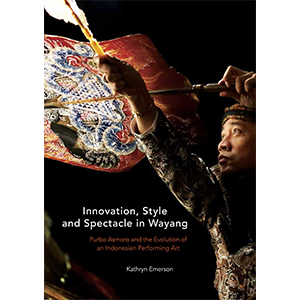Innovation, Style and Spectacle in Wayang: Purbo Asmoro and the Evolution of an Indonesian Performing Art
Wayang fascinates and endures thanks to the many ways it works as a medium — as bearer of Javanese culture and tradition, as key component of rites of passage, as a medium of ritual and spiritual practice, as public spectacle, and as entertainment of the broadest sort, performed live, broadcast or streamed. Over the last forty years, the form has been subject to a great deal of experimentation and innovation, pulled in these many directions, within an ever-changing media landscape, shaped in the most recent years by the constraints of pandemic response. Author Emerson outlines both the significant contributions by a number of key figures, and the societal or political influences propelling such innovations. She describes the deeper and more lasting changes in wayang, based on what the art form’s most accomplished practitioners have to say about it.
The ultimate focus of the work is one pivotal figure, Purbo Asmoro of the Indonesian Institute of the Arts in Surakarta, who the author argues has taken the individual and singular innovations of the era and integrated them into a new system of performance practice, one which has shaped the key Surakarta school of performance. The book is based on an unprecedented decades-long participatory research project involving hundreds of interlocutors. Written in a lively style and beautifully illustrated, the book will be of considerable interest in Indonesian studies, to wayang connoisseurs, and to anyone seeking to learn about a dynamic, contemporary art form that finds its energy outside the structures of Western theatre and media.
“No-one is better placed than Kitsie Emerson to explain the shadow puppetry of contemporary Java to a world audience. Building on decades of involvement as translator, musician, student, teacher, and promoter of wayang and gamelan, Emerson paints a vivid picture of the innovative performance style of master puppeteer Ki Purbo Asmoro. A must-read for all who are interested in the performing arts of Indonesia.”
– Bernard Arps, Leiden University
RM75.00
1 in stock
Description
Wayang fascinates and endures thanks to the many ways it works as a medium — as bearer of Javanese culture and tradition, as key component of rites of passage, as a medium of ritual and spiritual practice, as public spectacle, and as entertainment of the broadest sort, performed live, broadcast or streamed. Over the last forty years, the form has been subject to a great deal of experimentation and innovation, pulled in these many directions, within an ever-changing media landscape, shaped in the most recent years by the constraints of pandemic response. Author Emerson outlines both the significant contributions by a number of key figures, and the societal or political influences propelling such innovations. She describes the deeper and more lasting changes in wayang, based on what the art form’s most accomplished practitioners have to say about it.
The ultimate focus of the work is one pivotal figure, Purbo Asmoro of the Indonesian Institute of the Arts in Surakarta, who the author argues has taken the individual and singular innovations of the era and integrated them into a new system of performance practice, one which has shaped the key Surakarta school of performance. The book is based on an unprecedented decades-long participatory research project involving hundreds of interlocutors. Written in a lively style and beautifully illustrated, the book will be of considerable interest in Indonesian studies, to wayang connoisseurs, and to anyone seeking to learn about a dynamic, contemporary art form that finds its energy outside the structures of Western theatre and media.
“No-one is better placed than Kitsie Emerson to explain the shadow puppetry of contemporary Java to a world audience. Building on decades of involvement as translator, musician, student, teacher, and promoter of wayang and gamelan, Emerson paints a vivid picture of the innovative performance style of master puppeteer Ki Purbo Asmoro. A must-read for all who are interested in the performing arts of Indonesia.”
– Bernard Arps, Leiden University
Publisher: NUS Press
Paperback
2022
ISBN: 9789813251892

 Dancing The Malaysian
Dancing The Malaysian
 The Naive and The Sentimental Novelist: Understanding What Happens When We Write and Read Novels
The Naive and The Sentimental Novelist: Understanding What Happens When We Write and Read Novels
 Coming Of Age: A Decade Of Essays, 2001-2011
Coming Of Age: A Decade Of Essays, 2001-2011





